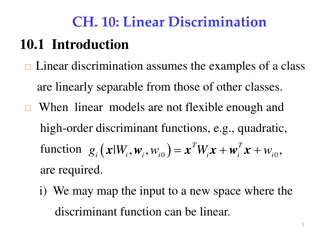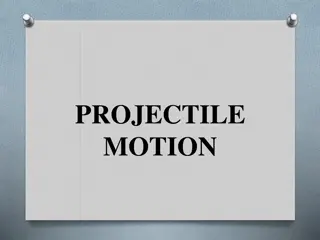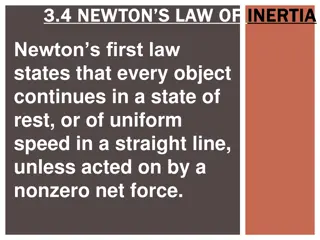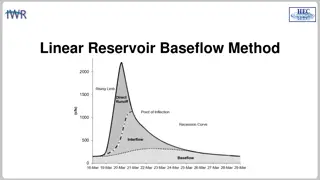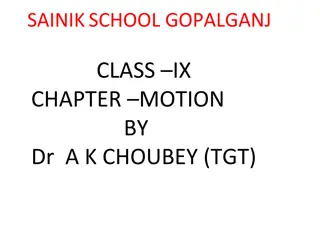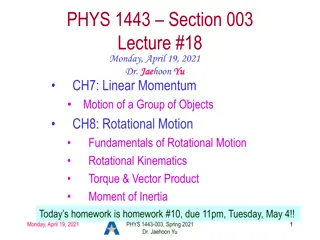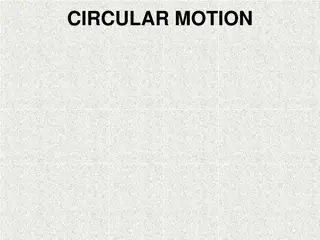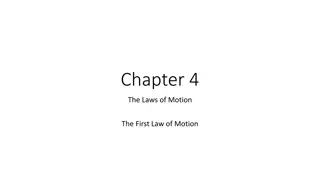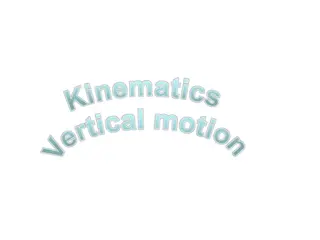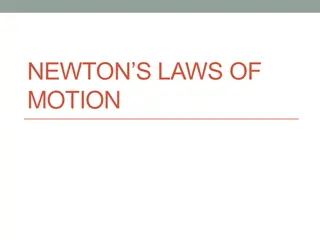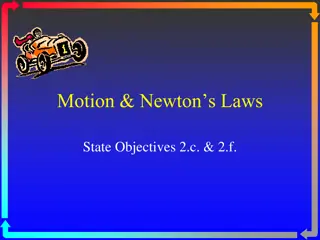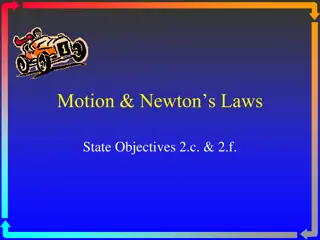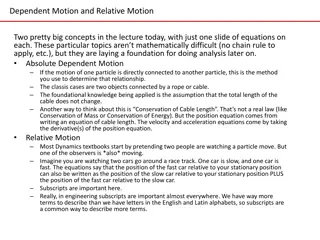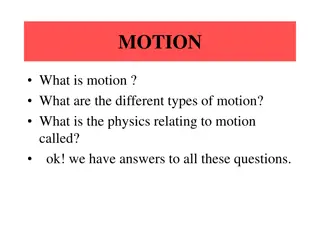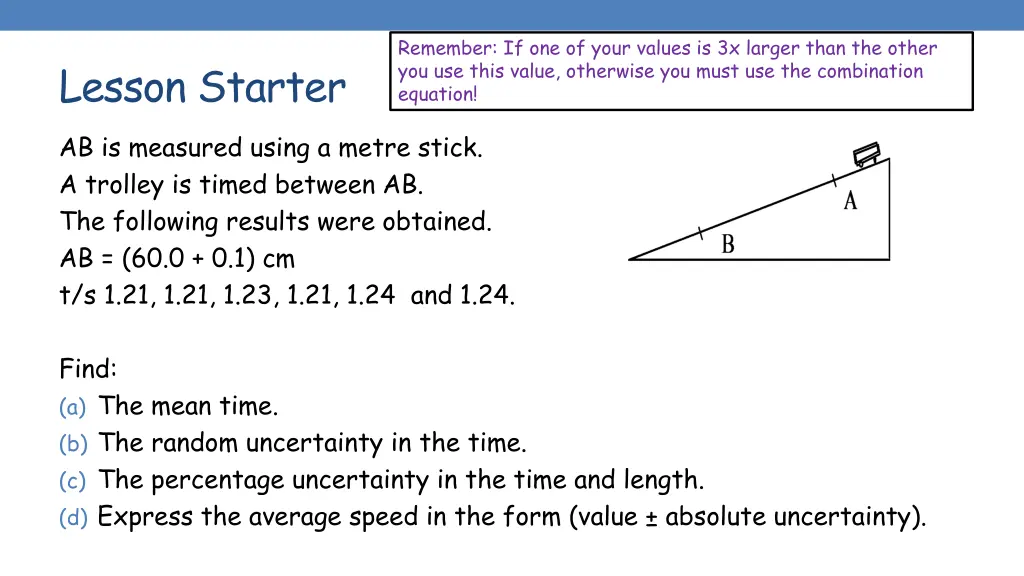
Uniform Acceleration Equations Derivation
Explore the derivation of uniform acceleration equations in physics, including velocity, displacement, and acceleration calculations. Understand the integration process and how vectors play a role in determining velocity and acceleration. Dive into the fundamental concepts of motion and how calculus methods are applied to determine instantaneous velocity and acceleration.
Download Presentation

Please find below an Image/Link to download the presentation.
The content on the website is provided AS IS for your information and personal use only. It may not be sold, licensed, or shared on other websites without obtaining consent from the author. If you encounter any issues during the download, it is possible that the publisher has removed the file from their server.
You are allowed to download the files provided on this website for personal or commercial use, subject to the condition that they are used lawfully. All files are the property of their respective owners.
The content on the website is provided AS IS for your information and personal use only. It may not be sold, licensed, or shared on other websites without obtaining consent from the author.
E N D
Presentation Transcript
Remember: If one of your values is 3x larger than the other you use this value, otherwise you must use the combination equation! Lesson Starter AB is measured using a metre stick. A trolley is timed between AB. The following results were obtained. AB = (60.0 + 0.1) cm t/s 1.21, 1.21, 1.23, 1.21, 1.24 and 1.24. Find: (a) The mean time. (b) The random uncertainty in the time. (c) The percentage uncertainty in the time and length. (d) Express the average speed in the form (value absolute uncertainty).
LINEAR MOTION Advanced Higher Physics
Copy into notes jotter: Calculus Methods The average velocity of an object can be found from the equation: ????????= ? ? is the change in displacement ? is the change in time. To find the instantaneous velocity, we must consider a very small time interval, so must find the derivative of displacement with respect to time: ? = ??? ? ? ? =?? ? (?? ? 0) ??
Copy into notes jotter: Calculus Methods We can find the average acceleration by using: ????????= ? ? To find instantaneous acceleration we will need to consider the rate of change of velocity with respect to time: ? = ??? ? ? =?? ? ?? ? 0 ?? Since ? =?? ??, the acceleration can also be written as: ? =? ?? ??=?2? Remember: Velocity and Acceleration Are VECTORS!! ??2 ??
Copy into notes jotter: Deriving the equations for uniform acceleration Acceleration is the rate of change of velocity: ? =?? ?? We are looking at motion where a is a constant. To find the velocity after time, we will integrate this expression over the time interval from t=0 to t=t. ? ?? = ?=0 Solve: ?? ? ? = ?? ? = ? + ?? ? ? ??? = ? ?? ? ?=0 ? ?= ? ?0
Copy into notes jotter: Deriving the equations for uniform acceleration Integrating over the time interval from 0 to t gives: ? ? ?? = ? + ?? ?? ?=0 ?=0 ? = ?? +1 2??2 ???? ?? ? = ?? +?
Deriving the equations for uniform acceleration To derive the third equation of motion, we rearrange ? = ? + ?? to give ? = ? ? ? and sub into ? = ?? +1 2??2: 2 x2a ? = ?(? ? ?) +1 2?? = 2? ? ? + ? ?2 2?? = 2?? 2?2+ ?2 2?? + ?2 2?? = ?2+ ?2 ??= ??+ ??? ? ? ? 2?
Deriving the equations for uniform acceleration It is also useful to remember that for an object moving in a straight line with uniform acceleration, the average velocity over a period of time is given by 2 The displacement can therefore be found from ? = ?+? . ?+? 2 ?
Horizontal Motion The kinematic relationships can be used to solve problems of motion in one dimension with constant acceleration. In all cases we will be ignoring the effects of air resistance.
Example A car accelerates from rest at a rate of 4.0 m s-2. 1. What is its velocity after 10 s? 2. How long does it take to travel 72 m? 3. How far has it travelled after 8.0 s?
Example Answer We can list the data given to us in the question = 0 m s-1 (the car starts from rest) = 4.0 m s-2 we will use the equation ? = ? + ??. ? = ? + ?? ? = 0 + 4?10 ? = ???? ?
Example 2. We can use ? = ?? +1 2??2 72 = 0?? +1 72 = 2?2 = 2?4??2 36 = ?? 3. After 8 seconds, we can use ? = ?? +1 2??2 24?82 ? = 0?8 +1 ? = ????
Copy into notes jotter: Tips The same strategy should be used in solving all of the problems for constant acceleration. list the data given to you in the question. It is often useful to make a sketch diagram with arrows, to ensure that any vector quantities are being measured in the correct direction.
Copy into notes jotter: Vertical Motion When dealing with freely-falling bodies on Earth, the acceleration of the body is the acceleration due to gravity, = -9.8 m s-2. If any force other than gravity is acting in the vertical plane, the body is no longer in free-fall, and the acceleration will take a different value. Problems should be solved using exactly the same method we used to solve horizontal motion problems.
Copy into notes jotter: Vertical Motion Example A student drops a stone from a second floor window, 15 m above the ground. 1. How long does it take for the stone to reach the ground? 2. With what velocity does it hit the ground?
Copy into notes jotter: Example answers Take care with the direction we choose as the positive direction. Here, if we take a as a positive acceleration, then v and s will also be positive in the downward direction. We are told that = 0 m s-1 = -9.8 m s-2 = -15 m 1. To find t, we use ? = ?? +1 -15 = 0?? + (1 15 = 4.9?2 2??2. 2? 9.8)?2 15 4.9 = = ?.??
Copy into notes jotter: Example answers 2. We can use ?2= ?2+ 2?? ?2= 0 + 2 ? 9.8 ? 15 ? = ? = ???? ? 294
Tips Difficulties sometimes occur when the initial velocity is directed upwards, for example if an object is being thrown upwards from the ground. To solve such a problem, it is usual to take the vertical displacement as being positive in the upwards direction. The velocity vector is then positive when the object is travelling upwards, and negative when it is returning to the ground. In this situation the acceleration is always negative, as it is always directed towards the ground.
Lesson Starter Write down the equation for instantaneous velocity. 1. 2. Write down the equation for instantaneous acceleration. 3. Derive the expression: v=u +at
Copy into notes jotter: Graphs for motion with constant velocity The graphs below all represent motion with a constant velocity: You will also recall from Higher that the area under a velocity time graph is equal to the displacement. Similarly, it is worth noting that the area under an acceleration time graph is equal to the change in velocity.
Copy into notes jotter: Graphs for motion with constant positive acceleration The graphs below all represent motion with a constant positive acceleration: Note that since acceleration and velocity are the same sign, the object is speeding up.
Copy into notes jotter: Graphs for motion with constant negative acceleration The graphs below all represent motion with a constant negative acceleration: Note that since the acceleration and the velocity are the opposite sign, the object is slowing down.
Example 1 For the velocity - time graph shown, calculate: 1. The acceleration from 2.0 s to 8.0 s. 2. The displacement after 8.0 s.
Example answers 1. ???????????? = ???????? ?? ? ? ???? = 15/6 = ?.? ?? ? or ? =? ? ? a = 5 10 6 ? = ?.??? ?
Copy into notes jotter: Example 2 Find the change in velocity in: 1. The first 5 seconds. 2. Between 0 and 30 seconds.
Copy into notes jotter: Example 2 answers 1. ? ???? ?? ???????? = ???? ????? ???????????? ???? ???? = 3?5 = ???? ? 2. ? ???? ?? ???????? = ???? ????? ???????????? ???? ???? = 15 3 (10? 0.3) = ???? ?
Objects in Free fall The displacement of an object with constant acceleration can be found from ? = ?? +1 For a dropped object, the initial velocity is 0 m s-1 and the acceleration is the acceleration due to gravity. So the value of g can be evaluated from the gradient of the straight line graph of s against ?2. 2??2
Finding g Experiment Measure several heights using a meter stick. Drop an object from these heights and time how long it takes to fall (complete 5 times). Get the mean time. Draw a graph of displacement vs time squared. Find g.
Copy into notes jotter: Objects in Free fall The acceleration due to gravity can also be found by considering the displacement-time graph. The gradient of the graph is increasing since the instantaneous velocity increases.
Copy into notes jotter: Objects in free fall The instantaneous velocity at a given time can be found by drawing a tangent to the graph and determining its gradient. To sketch a tangent to the graph, a straight line must be drawn such that it touches the curve only at one point. The acceleration due to gravity can then be found by substituting the values of v and t into the equation ? =? ? ?
Graphical methods for non-uniform acceleration For non-uniform acceleration, the change of velocity with time is not constant throughout the motion. So the slope of the velocity-time graph will be changing and it may have curved sections. Therefore, to find the acceleration at a given point in time, you need to draw a tangent to the curve at that point and then calculate its gradient.
Copy into notes jotter: Summary
Copy into notes jotter: Example 1 - Varying Acceleration The velocity in m s-1 of a moving particle is given by the equation ? = 4?3 5?2+ 6? Where t = time in seconds. Find the acceleration when t = 0.5s.
Copy into notes jotter: Answer 1 ? = 4?3 5?2+ 6? ?? ??= 12?2 10? + 6 ??= 12?0.52 10?0.5 + 6 ?? ??= ??? ? ??
Copy into notes jotter: Example 2 The acceleration of a space shuttle in m s-2 is described by the expression ? = 7.0?10 7?3 3.9?10 4?2+ (0.11)? + 0.86 Determine the change in velocity of the space shuttle throughout the first 100 seconds.
Copy into notes jotter: Example answer ? ?? ??= ? ?? ? 100 7.0?10 7?3 3.9?10 4?2+ 0.11 ? + 0.86?? = 0 100 7.0?10 7?4 4 3.9?10 4?3 3 0.11 ?2 2 ?= ?? + + 0.86? 0 (C is omitted as it would be in both sides) 7.0?10 71004 4 3.9?10 41003 3 0.11 1002 2 ? ? = + + 0.86?100 0
Copy into notes jotter: Answer cont ? = 17.5 130 + 550 + 86 0 ? = ????? ?
Copy into notes jotter: Example 3 When a car brakes to a halt, the displacement of the car from a reference point can be described by the equation ? = 5.8? 2.5?2 Sketch a displacement time graph for the motion.
Copy into notes jotter: Answer ? =?? ??=? ? = 5.8 5? 5.8? 2.5?2 ?? ? ?? ? = 0?? 1,? =5.8 ? = 5.8?1.16 2.5?1.162 ? = 3.4? = 1.16? 5
Tutorial Questions You can now complete all of tutorial 1
Lesson Starter Derive the expression: s = ?? +1 1. 2??2 2. What is the acceleration of a particles, whose velocity is described by the expression: v = 20?2 5?3 3. Is the acceleration a constant? Explain.

